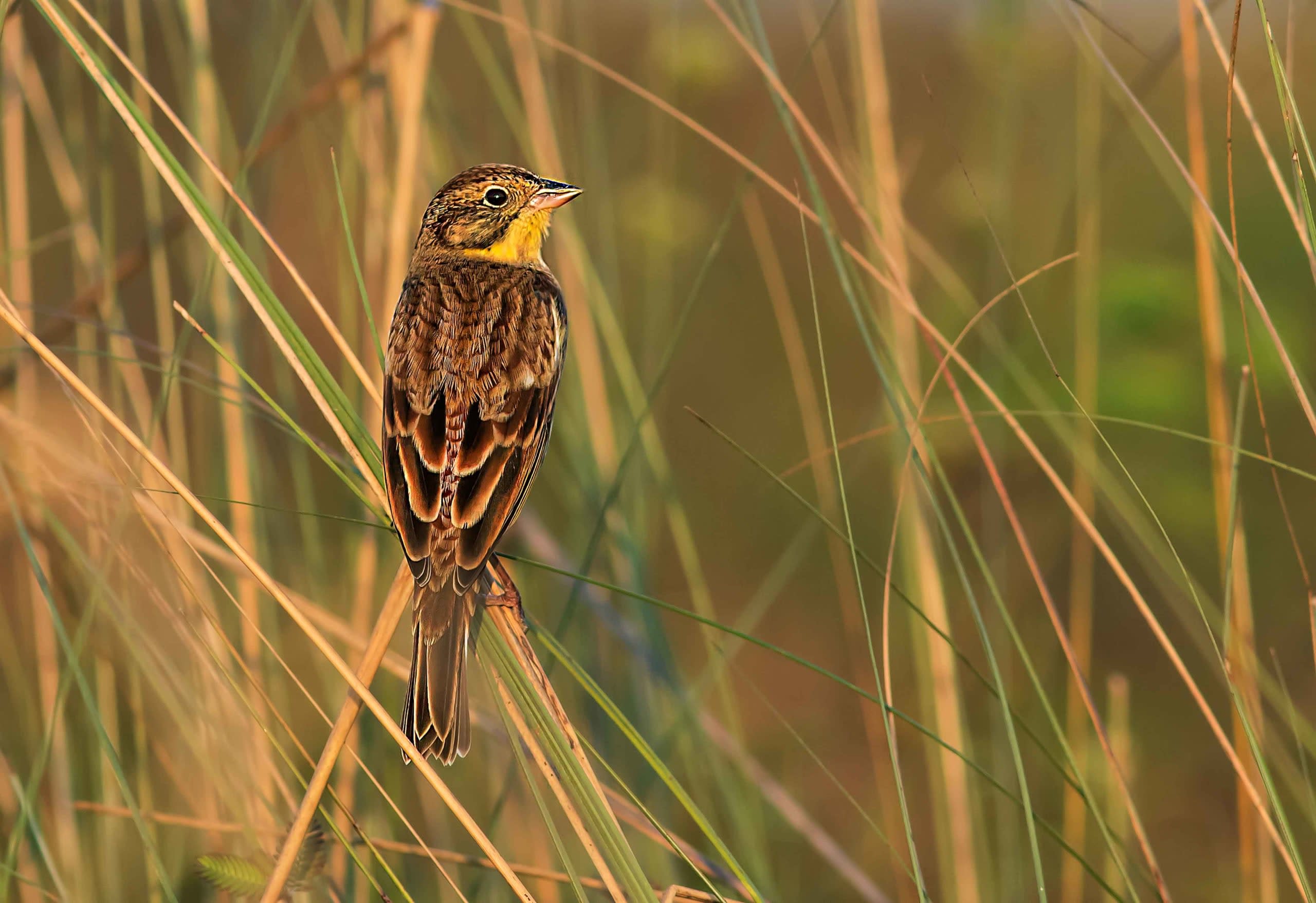 Listen to this article
•
15:34 min
Listen to this article
•
15:34 min
After the extinction of the famous passenger pigeon — a social bird that lived in dense flocks of thousands — it became apparent that large numbers are not a guarantee of species survival in a human-dominated world. Passenger pigeons were in the billions, especially in North America, but unrestricted hunting on an industrial scale pushed the bird to extinction in less than 150 years. The last passenger pigeon, Martha, died in a Cincinnati Zoo, in the USA, on September 1, 1914. The way the yellow-breasted bunting has been hunted, it could meet the same fate.
The yellow-breasted bunting (Emberiza aureola) is a medium-sized bird with mostly yellow underparts and a broad white wing bar on its upper wings. It has a large conical bill with a pale lower mandible. In the breeding season, the male dons a black mask, and its plumage becomes brighter. The female is similar to other Emberiza buntings, with a heavily streaked grey-brown back and less intense yellow underparts. It has a whitish face with a dark crown and cheek stripes. Like the passenger pigeon, it formerly gathered in immense flocks or “swarms” of up to 200. However, these numbers have declined across its range.

Cover photo: The yellow-breasted bunting is a winter visitor to the eastern states of India, including West Bengal. Photo: Avijan Saha
The yellow-breasted bunting has a wide range from Finland in Europe to eastern Siberia. During the winters, it travels to warmer climates in South and Southeast Asia. In India, it is reported as a winter visitor mainly in the eastern states: Sikkim, West Bengal, Assam, Arunachal Pradesh, Meghalaya, Manipur, and some parts of north India. Here, it breeds in wet meadows with tall vegetation and scattered scrubs. About 100 years ago, it was a common winter visitor in India. It was particularly seen in large flocks in Manipur.
In 2008, photographer Avijan Saha spotted 15-20 flocks of buntings in the Fulbari Wetland in the state. This is a rare sighting of the bird in recent times.
Historic decline
The reason for its decline is largely due to the extreme trapping of the bird across Southeast Asia. In China, the yellow-breasted bunting is a victim of commercial sale, trapping, and trade. These birds are popularly known as “rice birds” in China as they forage in harvested rice fields in chattering flocks. They used to occur in “swarms” at migration watchpoints such as Beidaihe, China, but no more.

According to BirdLife International, yellow-breasted buntings are trapped, cooked and sold as “sparrows” or “rice-birds”, particularly in mainland China. This is a major threat to them. Although it is illegal in some areas, over a million individuals are killed annually to be sold as snacks. According to Andy Symes, Global Species Officer (Red List Coordination) BirdLife International, from 1992 onwards, several thousand individuals of this species were caught for the annual food festival in Sanshui City, southern China. This practice was banned in 1997, but a black market of birds persists, and a huge number of birds are sold annually, including around 10,000 birds sold daily in a single market in Sanshui. In China, thousands of males are also stuffed and sold as mascots since their presence in the home is thought to confer happiness. In Cambodia, these birds are trapped for “merit release” in temples as a religious ritual. It’s ironic that we trap birds to “release” them! Although China has recently banned its trapping and sale, the “swarms” are already a part of history.
Across the yellow-breasted bunting’s range, the shift to irrigated rice production has led to the loss of reedbeds and reduced the number of available roost sites. Their wintering grounds and breeding grounds have also been adversely affected by the drying of marshy meadows caused by dam construction changing river flow patterns.
Twenty-year free fall
Dr Simba Chan, formerly with BirdLife International and one of the most active conservationists from Hong Kong, wrote a paper in 2004 in BirdingASIA, a journal of the Oriental Bird Club, UK. The article triggered more research and subsequent uplisting of the species from “Least Concern” to “Near Threatened”. As more information was gathered, it became clear that this once-abundant bird was on a free fall. Therefore, from 2008 it was treated as a threatened species, and IUCN listed it as “Vulnerable”, modifying that to “Endangered” in 2013, and finally “Critically Endangered” in 2017.
Between 1980 and 2013, the population declined by 84.3-94.7 per cent, and the western range limit retracted 5,000 km to the east. Since BirdLife International highlighted the plight of the yellow-breasted bunting nearly 20 years ago, China has taken many conservation measures.

Conservation plans
Simba Chan says, “Hunting yellow-breasted buntings was a very serious issue in China… However, through advocacy and raising awareness in the last decades, the situation has improved. It is now listed in the highest national protection category, and local bird conservation organisations have started monitoring and education programmes in southern China. In late 2020, local conservation organisations in Guangzhou proposed November 15 as ‘International Yellow-breasted Bunting Day’. I believe the success story of its conservation will inspire more conservation activities of passerines in Asia.” However, such special days and rituals cannot save the species unless the law is enforced strictly, and trapping and sale of these birds totally banned. We cannot afford to have another “passenger pigeon” in the avian world.
In India, we have an example of conservation success with the amur falcon. Until 2012, in Nagaland, locals trapped thousands of amur falcons in the name of traditional rights, but quick action by the Government of India, the Nagaland Government, and NGOs in 2013 put a stop to commercial trapping of these migrating raptors. Let us hope the Chinese government will also put a complete stop to the trapping of these “rice birds”.







